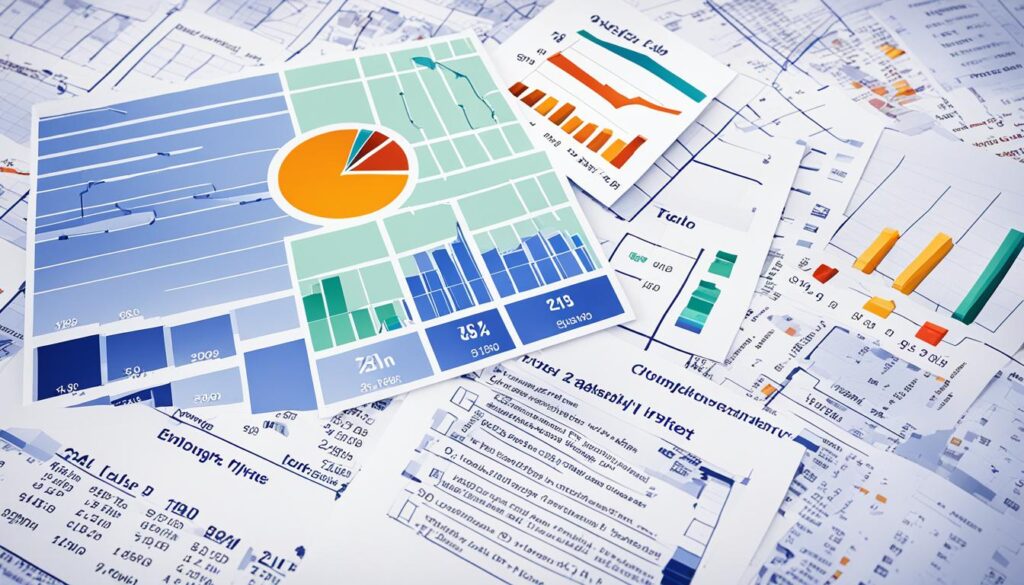A real estate market analysis, also known as a comparative market analysis, is a key tool for investors. It helps them see if a property is a good investment or to check an area’s rental potential. This process looks at the current prices of similar properties. By doing this, investors can understand the market better and make smart choices.
Key Takeaways:
- A real estate market analysis is a valuable tool for investors to determine property value and make informed decisions.
- It involves analyzing current market values of comparable properties.
- Real estate market analysis helps interpret market trends and assess rental potential.
- By understanding the current market, investors can determine property values accurately.
- Making informed decisions based on a market analysis improves chances of success in the real estate market.
The Importance of Real Estate Market Analysis
Understanding real estate markets is crucial for investors. It helps them make safe choices. They can see a project’s potential and decide if it’s a good idea. They also learn a property’s real worth by comparing it with others.
This analysis is key for knowing a property’s income or growth. It helps investors choose wisely and lower risks.
Real estate market analysis is key for knowing a property’s worth and making smart choices.
This method gathers info from sales, trends, economy, and people living nearby. It gives a full view of a property’s value and surroundings. This way, investors know what they’re getting into.
It also tells investors how tough the market is in an area. This helps spot good chances in places people want but few are selling. So, by checking the market, investors plan to get more profits.
Market analysis is vital for making smart investments. It lets investors act on solid research. Staying informed about market shifts and needs is crucial for doing well.
Benefits of Real Estate Market Analysis:
- Gather valuable information to make informed investment decisions
- Identify market potential and commercial viability
- Determine property value and negotiate fair prices
- Assess rental income potential
- Minimize risks by understanding market conditions
| Benefits | Real Estate Market Analysis |
|---|---|
| 1 | Gathers information for informed decisions |
| 2 | Identifies market potential and commercial viability |
| 3 | Determines property value and negotiates fair prices |
| 4 | Assesses rental income potential |
| 5 | Minimizes risks by understanding market conditions |
| 6 | Stays competitive by analyzing trends and competition |

It is a needed tool for investors aiming to excel in real estate. By learning all they can, they make choices that boost their profits. This ensures they stay successful over time in this competitive industry.
Conducting a Real Estate Market Analysis
Looking into a real estate market means gathering key info to make smart choices. Here’s an in-depth look at the steps:
1. Market Research
Start with deep market research to get local real estate market data. This data covers recent property sales, trends, values, and rent rates. It gives insight into the market’s current state and a property’s investment potential.
2. Property Analysis
Then, analyze the property itself. Review the location, neighborhood, lot and construction size, and amenities. This shows how attractive the property is and its value or rent income potential.
3. Assessing the Original Price
Check the property’s original listing price. This lets you know the property’s state and what updates it might need. The original price guides understanding the seller’s thoughts and finding a fair value.
4. Comparisons with Similar Properties
Comparing with similar properties sets its market value. Find similar ones in location, size, and condition. Use their sale prices to set a price for the target property.
“A thorough real estate market analysis involves market research, property analysis, original price assessment, and comparisons with similar properties.”
By looking at all these steps, you can find the right market value for the property. This keeps you from paying too much or too little.
Example Table: Comparisons with Similar Properties
| Property | Location | Size (sqft) | Amenities | Sale Price |
|---|---|---|---|---|
| Property A | Downtown | 1,200 | Pool, Gym | $300,000 |
| Property B | Suburb | 1,500 | Park, Playground | $250,000 |
| Property C | City Center | 1,000 | Security, Parking | $350,000 |
By comparing with similar properties, you know if the target property is fairly priced. This helps you understand the market and the property’s worth.
Doing a real estate market analysis is key for good investment choices and higher returns. Follow these steps to gauge the market value properly and enter the real estate world with certainty.
Segments of Real Estate Market Analysis
Real estate market analysis has four key parts: market, demand, supply, and environment. Each gives key insights into various market aspects. This helps investors make smart choices and handle the industry’s challenges.
Market Segment
Market analysis looks at the overall market size, trends, and growth potential. It checks the current market, finds changes or patterns, and forecasts future changes. This part lets investors see how attractive a location or property type is for investment.
Demand Segment
The demand part focuses on people and how they act in the market. It looks into buying rates, what buyers or renters want, and who the best market is. Understanding demand helps investors find their audience, customize their products, and improve their marketing.
Supply Segment
The supply part examines what’s available in a market. It looks at competitors, their products, and their success. By learning about supply, investors can see how full the market is, find gaps, and choose the best property development, pricing, and when to enter the market.
Environmental Segment
The environment part checks outside factors that affect the market. This includes laws, new tech, public works, and other market influences. This part helps investors know the risks and opportunities of a location or property type. It makes sure they look at all factors when making choices.
Studying these four market segments gives investors a deep look into market dynamics. They can spot opportunities, lower risks, and choose wisely where to invest.

Data Collection and Analysis in Real Estate Market Analysis
Collecting data is key in real estate market analysis. It involves getting info to understand the market’s potential and find good investment chances. Various methods and tools are used to ensure the data is accurate and reliable.
One way to collect data is through surveys. They gather insights from people like potential buyers and sellers. This info is about what customers like, market trends, and what they want.

Using analytics tools is crucial too. These tools help pull out important info from lots of data. They allow analysts to spot patterns and trends. This helps investors understand the market better and make smart choices.
Looking at data from outside sources is also very important. This can be from government reports, magazines, or research studies. Adding data from these reliable sources improves the quality of the analysis and the conclusions drawn.
Benefits of Data Collection in Real Estate Market Analysis
- Informed Decisions: Data collection allows for smarter choices. It gives investors clear insights and trends in the market.
- Identifying Opportunities: Through data analysis, investors can find new trends and areas to invest in.
- Risk Mitigation: Collecting data helps understand and reduce possible risks in the market.
- Competitor Analysis: Knowing what competitors are doing helps investors stand out and place their investments well.
Effective data collection is key in real estate market analysis. It helps investors make informed decisions and earn more from their investments. Using the right tools and methods is crucial for success.
Presenting a Real Estate Market Analysis Report
When the analysis of the real estate market is done, creating a detailed report is crucial. This report shows all the data, analysis, and insights needed for smart decisions. It is a key tool for everyone involved to know the market and property values.
Data visualization is a great way to share all this information. Charts, graphs, and maps turn complex data into easy-to-read visuals. This helps everyone understand what influences the market and make better choices.
The report will point out the major trends and patterns. It gives an overview of market conditions like supply and demand, growth, and risks. Showing these details helps people get a clear view of the real estate market.
The report doesn’t just talk about trends. It also offers advice based on what was found, helping investors know where to look or what to avoid. This makes the report a key guide for moving through the real estate market.
Example Market Analysis Report
| Section | Description |
|---|---|
| Executive Summary | Provides a high-level overview of the analysis report, including key findings and recommendations. |
| Market Overview | Gives an in-depth analysis of the current real estate market, including market size, trends, and growth potential. |
| Property Analysis | Evaluates specific properties and their attributes, such as location, amenities, and condition, to assess their market value. |
| Comparative Market Analysis | Compares the subject property with similar properties in the market to determine its fair market value. |
| Trends and Insights | Highlights significant trends, patterns, and insights discovered during the analysis process. |
| Recommendations | Provides actionable recommendations based on the analysis, guiding stakeholders in their decision-making process. |
The example report shows what sections a real estate analysis report usually has. A well-presented report with good visuals helps people understand and act on the information better.

Having a detailed and clear report means stakeholders can make better choices in real estate. This report is a key part of understanding market conditions, gaining insights, and making informed decisions.
Benefits of Data-Driven Real Estate Market Analysis
Data-driven analysis in real estate offers big advantages to investors. It helps make smart, well-informed choices. This way, the chance of picking bad investments goes down. Here’s a look at why looking at the numbers is good for real estate decisions:
- Accurate Decisions: This method lets investors understand the market and values better. They choose options that fit well with how the market is moving. It means their choices are more likely to lead to success.
- Improved Decision-Making: Getting deep into the data makes decision-making more powerful. It helps spot new chances, weigh the risks, and use any advantages they have. This keeps them ahead and helps them choose wisely.
- Minimized Risk: Using data cuts the chance of making bad investment moves. Investors look closely at market changes and property values to avoid traps. They make choices based on facts rather than guesses, saving their money and securing their future.
By analyzing the data, investors can move with confidence. They understand market trends, risks, and new chances better. This approach helps them succeed in real estate by making sure their choices are well-informed.
Table: Key Advantages of Data-Driven Real Estate Market Analysis
| Advantages | Description |
|————————-|——————————————————————————————————|
| Accurate Decisions | Making precise investment decisions based on reliable data |
| Improved Decision-Making| Enhancing the decision-making process and staying ahead of the competition |
| Minimized Risk | Reducing the risk of poor investments and protecting investment capital |
Source: [Investor Insights, 2021](https://www.investorinsights.io/data-driven-real-estate-market-analysis-benefits/)
Comparative Market Analysis (CMA) in Real Estate
Comparative Market Analysis (CMA) is a key part of real estate. It helps figure out how much a home is worth by looking at others sold nearby. This helps agents and clients know the right price for buying or selling a home.
Real estate agents look at many details to find the property’s true value. They check the location, size, look, and what’s special about it. By looking closely at these things, they can know the home’s worth right now.
“A Comparative Market Analysis gives insight into property values. This helps buyers and sellers decide with more smarts.”
Agents use CMAs to advise buyers on what’s a good deal and to help sellers set smart prices. By seeing recent sale prices of similar homes, agents can give solid advice. This makes for better deals.
More so, CMAs let agents keep up with market ups and downs. Always learning about the market lets them offer the best advice to their clients. Good advice helps clients make wise choices when buying or selling.
Benefits of Comparative Market Analysis:
- Estimate property value: A CMA sets the right price by looking at recent sales nearby.
- Assist buyers and sellers: It guides buyers to make strong offers and helps sellers with realistic prices.
- Informed decision-making: With a CMA, people know exactly what they’re doing when they decide on a home.
Example of a Comparative Market Analysis Report:
Here’s a sample Comparative Market Analysis report:
| Property | Location | Square Footage | Condition | Features | Sale Price |
|---|---|---|---|---|---|
| Property A | City X | 2,000 sqft | Excellent | Swimming pool, balcony | $500,000 |
| Property B | City X | 2,200 sqft | Good | Backyard, fireplace | $480,000 |
| Property C | City X | 1,800 sqft | Fair | No backyard, renovation needed | $420,000 |
This report looks at three homes recently sold in one area. It gives a deep look at current market trends. Plus, it helps find the right price for a home by looking at similar homes’ prices, looks, and sales.
Comparative Market Analysis vs. Appraisal
It’s key to know the difference between comparative market analysis (CMA) and appraisal when evaluating a property’s value. Both shine a light but for different reasons in real estate dealings.
Comparative market analysis is done by experts to figure out a property’s value. They look at recent sales of similar properties. They also review its location, size, condition, and features. This helps figure out a good price for the property.
Yet, a property appraisal is a more official check by licensed appraisers. It finds the property’s value specifically for loan reasons. Appraisers look at the property’s state, what’s sold lately nearby, and market trends. They aim to give a fair and accurate value for the property.
Both CMAs and appraisals tell us about a property’s worth. Still, it’s crucial to understand why they’re different. CMAs help in setting prices, talking deals, and checking the market. Appraisals are needed for loans, setting a real, unbiased value.
Here’s a quick compare and contrast of comparative market analysis and property appraisal:
| Comparative Market Analysis (CMA) | Property Appraisal |
|---|---|
| Estimate of the property’s value | Formal evaluation of the property’s value |
| Conducted by real estate professionals | Performed by licensed appraisers |
| Based on comparable property sales data | Considers property condition, recent sales, and market trends |
| Assists in pricing decisions and negotiations | Required for mortgage approval |
Getting the difference between CMA and appraisal helps pros and investors. They can choose better with correct property values and market details.
Conclusion
Real estate market analysis is key to knowing a property’s value. It lets people in real estate make smart choices. They do this by deeply researching the market and understanding the data.
Investors use this knowledge to set the right prices for their properties. It also helps them in negotiations. By knowing market trends, they stand a better chance of doing well in real estate.
This kind of analysis is crucial for those in the market, buying, selling, or renting. It gives them the power to make confident choices. This is possible through detailed analysis and knowing the real estate world.
FAQ
What is a real estate market analysis?
A real estate market analysis, or comparative market analysis, looks at a property’s value. It checks the rental potential too. It studies how much comparable properties are worth now.
Why is real estate market analysis important?
It is key for investors to gather info and invest wisely. This analysis uncovers market potential and helps compare properties. It ensures you pay a fair price.
How is a real estate market analysis conducted?
First, we collect data like area details and amenities. Then, we look at a property’s original price and compare. This makes sure we set a right value.
What are the segments of real estate market analysis?
The analysis has four parts: market, demand, supply, and environment. It checks the market’s size and growth. It also looks at what draws buyers, and your competition. Environmental factors are studied too.
How is data collected and analyzed in real estate market analysis?
Collecting data is vital. It helps know the market’s health and avoid bad investments. Surveys and software organize data for insights. This helps in decision-making.
How is a real estate market analysis report presented?
After the analysis, a detailed report is made. It shows the data, insights, and recommendations. Visual tools make the information clear. This report helps everyone understand the market and property’s worth.
What are the benefits of data-driven real estate market analysis?
It makes decisions based on real data to avoid guesses. By understanding market trends, investors make better choices. This approach highlights opportunities and potential risks.
What is comparative market analysis (CMA) in real estate?
CMA estimates a property’s value by checking similar recent sales. Agents use it to price homes correctly. They look at location, size, condition, and features.
How does comparative market analysis (CMA) differ from property appraisal?
CMA estimates value using recent sales, while appraisal is formal and needed for mortgages. CMAs provide insights, but appraisals are more regulated for loans.
Why is real estate market analysis important for property valuation and informed decision making?
Market analysis is critical for setting the right property value and making smart choices. It helps investors understand the property’s true value. Knowing what affects prices leads to better deals and success in real estate.


















